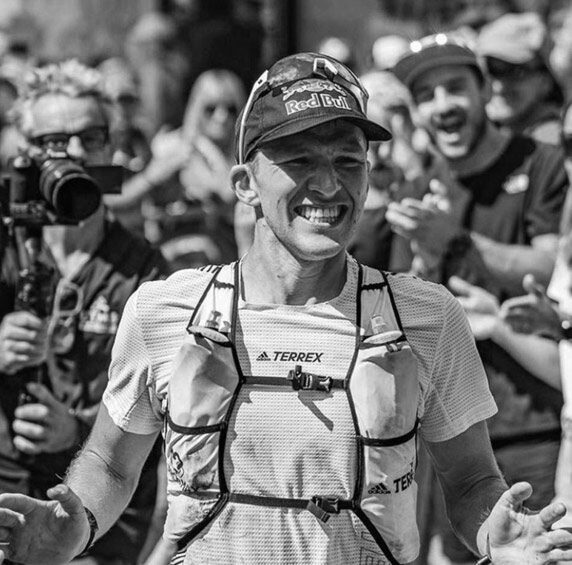Above: Evoke Endurance athlete Tom Evans, winner of the 2023 Western States Endurance Run 100mile race uses both RPE and HR in his training
I’ve been seeing a lot of chatter online about the relative merits of using Rate of Perceived Exertion (RPE) versus Heart Rate to control the intensity of endurance training.
We believe that most of the people involved in this debate are missing a third and in our opinion, the best option: Rather than use RPE or HR, use RPE and HR to monitor and control the intensity of endurance training.
Jump Ahead To:
ToggleRPE Pros and Cons
RPE essentially means allowing the feeling of the effort of your exercise to be the control. RPE is measured on a 1-10 scale.
RPE Scale
10 > Max Effort: Unable to talk. Impossible to sustain for more than 1 minute.
9 > Very Hard: Can speak only a few words while gasping for air.
7-8 > Vigorous: Borderline uncomfortable. Can speak a short sentence.
4-6 > Moderate: Short sentence conversation possible. Can sustain for 30-60 minutes
2-3 > Light: Conversational pace. Sustainable for hours.
1 > Very Light: Very low exertion. Like a brisk walk
Pros:
- It is almost foolproof when talking about RPE levels of 1 or 9 and 10. The sensations of those intensities are quite profound and hard to misread. This simplicity is a definite pro.
Cons:
- Most of the endurance training of athletes engaged in the mountain sports we cater to will spend the bulk of their training time at levels of RPE 2-6 with a small component in RPE level 7-8. Especially in the RPE intensity zones of 2-6, the differences are much harder pick up and differentiate. The body’s feedback will be much more subtle and harder to interpret. This lack of precision is a definite drawback.
- Endurance athletes end to be competitive (even if only with themselves) Type A personalities. These folks tend to push the intensity/speed boundaries in training if not constrained in some definitive manner.
- You may start a workout or a particular rep in an interval workout at one RPE but that RPE will inevitable climb during the workout. Which RPE should you be using?
- Because the RPE scale become unreliable in the critical highest volume training intensities and because Con #2 is so prevalent, emotions can easily overpower the discipline required to train at the right intensity. I see overtrained athletes often who have relied on RPE alone.
- I often use blood lactate measurements to remove the guesswork from the intensity zone scale. A typical Zone 2 (aerobic threshold) blood lactate reading for all athletes will fall somewhere between 2 and 2.5mMol/L. I have tested athletes whose RPE was in the 2-4 range (the RPE that should correlate with the aerobic threshold) who had blood lactates of 7mMol/L and higher (one notable one was a Crossfit instructor). These are lactate levels we normally see with athletes with an RPE of 8-9.
- Very well aerobically conditioned athletes will have a high RPE at their aerobic threshold because they are moving so fast. A couple of pro ultra runners we coach have an aerobic threshold running pace of 5min/mile (3min/km). It takes some effort to run this fast. While an aerobically deficient athlete might have an RPE of 1 at his aerobic threshold these elites will have RPE closer to 4-5.
- Because of my work on over training syndrome I have had many consultations with overtrained athletes who came to me looking for advice. In almost every case, at some point in our conversation, they will say “It felt like I was training easily enough.”
HR as a control
Let’s start with the acknowledgment that heart rate is also an imperfect means of monitoring or controlling intensity. It’s got its own set of problems that we’ll describe. But it has some distinct advantages over RPE that we’ll dive into in a minute.
Next, let’s dispense first with the lazy man’s way of setting up an HR intensity zone scale. That’s using a formula that relates percentages of max heart rate to intensity. Formulas and percentages sound so scientific. What could be wrong with that approach? What is wrong with it is so fundamental that the whole idea of using this method must be tossed out.
The formulas used to identify intensity zones by the percentage of max HR is a one-size-fits-all all approach. Like most one size fits all things it may or may not fit your personal physiology. Each individual will have a distinct metabolic and HR response to changes in exercise intensity. Over my 30-year coaching career working with every level of athlete: teens, fit amateurs, middle-aged beginners, Olympians, and professional mountain athletes, I have personally measured aerobic thresholds that varied from 50% to 90% of max HR and anaerobic thresholds between 60 and 95% of max HR. While it is possible that your physiology may fit perfectly into this formulaic structure you will be making a big assumption with no supporting data that pertains directly to you.
If you are going to use an HR zone system you should, at the very least, anchor that system to your own personal response to varying exercise intensity. We use two very simple tests to individualize your zone system.
Pros
- There is a good correlation between HR and the metabolic processes driving endurance in the intensity zones that mountain athletes are going to be spending the bulk of their training volume in. Not perfect but good enough.
- There is no fooling your HR, no emotional way to overlook what your HR is. This takes the emotional component out of controlling intensity.
- The tests to determine your zones are simple and free and you can retest to monitor training progress.
Cons
- The expense of buying an HR monitor
- The frustration of having to face the reality that you are not as fit as you want to be or think you are. This is the single biggest reason I see people not wanting to use HR.
HR and RPE
This method brings together the best of both these methods. Learning to listen to your body’s subtle feedback while correlating that to the physio-metric of HR will teach you a lot about your body and produce the best gains longer term.
A very simple rule of thumb:
High RPE with low HR may indicate fatigue
Low RPE with high HR may indicate freshness
This is just one example of the benefits of combining the objective HR with the subjective RPE.
Why would you not want to use RPE and HR?
Some Science
The latest edition of the textbook Endurance Training Science and Practice edited by Inigo Mujika examines several studies that compared various means of assessing training load and adaptation. This image shows a chart of their summary of those studies. Below this image is our explanation of what these several terms mean.

In the context of assessing endurance training adaptations, heart rate (HR) measures and the Rating of Perceived Exertion (RPE) offer different levels of effectiveness. The reliability of these measures is indicated by their variation—lower variation percentages suggest more consistent and dependable results. Exercise HR stands out as the most reliable measure, with only 1 – 3.5% variation, meaning it provides stable and repeatable data across different tests. It also shows moderate convergent validity, meaning it correlates well with other established methods of assessing physiological states, making it a valuable tool in training assessments. Additionally, Exercise HR has a signal-to-noise ratio (SNR) of 1.6, indicating that the true heart rate response is relatively strong and easily distinguishable from any random fluctuations or measurement errors.
RPE, with a moderate variation of 12.6%, provides fairly consistent measurements but is inherently more subjective, which can introduce variability based on factors like motivation or fatigue. RPE also has a lower SNR of 0.8, meaning that the signal—the true perceived exertion—may be less distinct from the noise, or random variability, in the data. While Exercise HR is generally more reliable and valid, RPE can still be useful as a supplementary tool within a broader assessment framework, particularly in capturing the psychological and neuromuscular aspects of performance.
References
- Shushan, T., McLaren, S. J., Buchheit, M., Scott, T. J., Barrett, S., & Lovell, R. (2022). Submaximal fitness tests in team sports: A theoretical framework for evaluating physiological state. Sports Medicine, 52(10), 2151-2163. https://doi.org/10.1007/s40279-022-01688-7
- Shushan, T., Lovell, R., Buchheit, M., Scott, T. J., Barrett, S., Norris, D., & McLaren, S. J. (2022). Submaximal fitness test in team sports: A systematic review and meta-analysis of exercise heart rate measurement properties. Frontiers in Sports and Active Living, 4, Article 946389. https://doi.org/10.3389/fspor.2022.946389
- Buchheit, M. (2014). Monitoring training status with HR measures: do all roads lead to Rome? Frontiers in Physiology, 5, 73.
- Gibson, N., Easton, C., Williams, M., McCunn, R., & Gibson, N. V. (2022). Reliability and Validity of a 6-Minute Yo-Yo Intermittent Endurance Test Level 2 in Subelite Part Time Male Soccer Players. Journal of strength and conditioning research, 36(4), 1011–1018. https://doi.org/10.1519/JSC.0000000000003641
- Fanchini, M., Schena, F., Castagna, C., Petruolo, A., Combi, F., McCall, A., & Impellizzeri, M. (2015). External Responsiveness of the Yo-Yo IR Test Level 1 in High-level Male Soccer Players. International journal of sports medicine,36(9), 735–741. https://doi.org/10.1055/s-0035-1547223
- Owen, A. L., Newton, M., Shovlin, A., & Malone, S. (2020). The Use of Small-Sided Games as an Aerobic Fitness Assessment Supplement Within Elite Level Professional Soccer. Journal of human kinetics, 71, 243–253. https://doi.org/10.2478/hukin-2019-0086



 Facebook
Facebook

It would be nice to see Training Peaks and other platforms support an RPE rating for each “Lap” marked by the athlete in a long run/workout. This would offer the opportunity for more precise metrics.
For instance, did the warm-up feel hard but the actual intervals were easier than usual? Or if I hit the Lap button at the bottom of a big climb, I can give that specific climb an RPE. I could use that same climb/RPE as an easily repeatable measure for how my fitness is progressing (or not progressing).
John:
TP does have a sliding scale for how the training feels to you. It’s not actually on the RPE scale but it is leaning in that direction. This feature is only available on the Premium editions though. And I don’t see a way to parse different workout segments with a similar “RPE” rating. Another way to gage workout RPE than HR is with power. If you train on the same terrain frequently you can see how much power you are making on different segments.
Your suggestion is a good one but we don’t have any pull at TP to get changes like this.
Scott